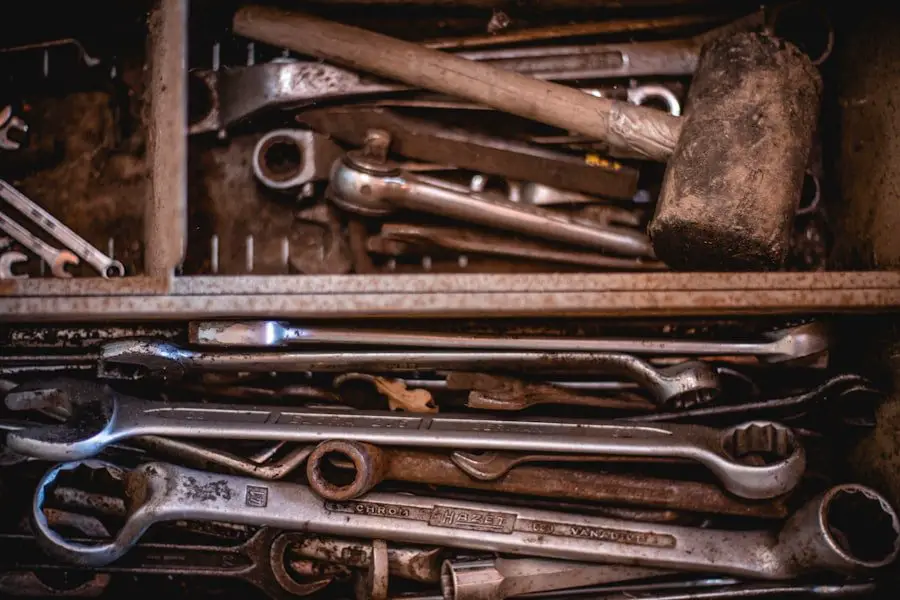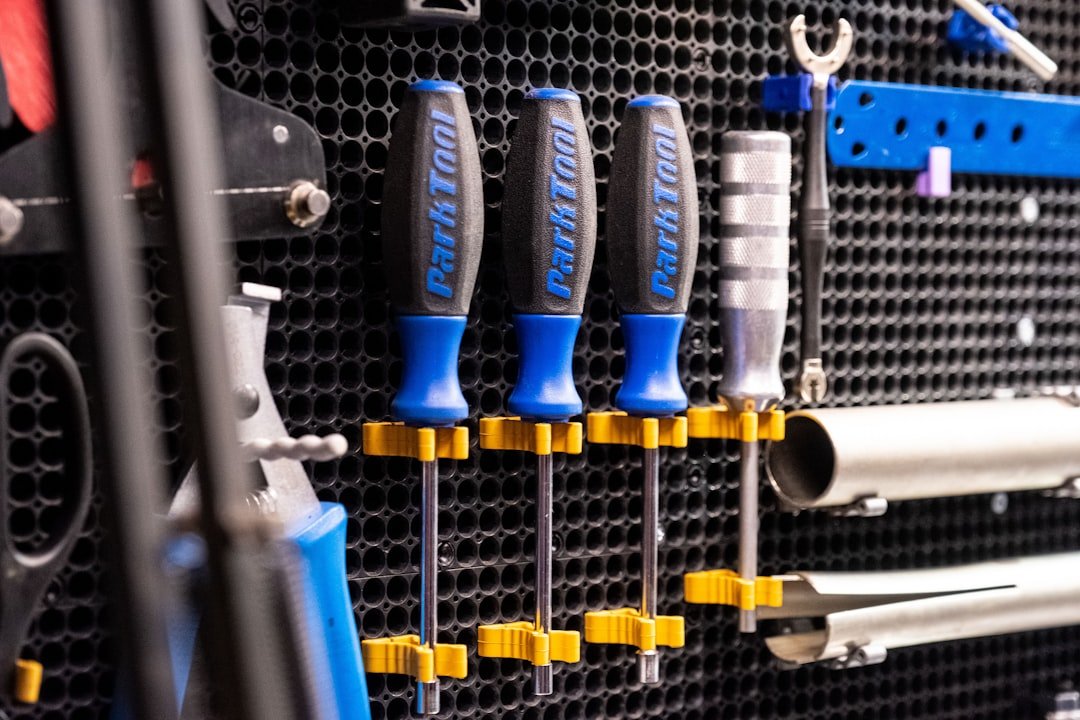Essential tools for DIY projects include both hand tools and power tools. Basic hand tools that are necessary for most projects are:
1. Hammer for driving and removing nails
2.
Screwdrivers in various sizes and types
3. Tape measure for accurate measurements
4. Level to ensure straight and even surfaces
5.
Utility knife for cutting materials
6. Pliers for gripping, twisting, and cutting wires
7. Adjustable wrenches for tightening and loosening nuts and bolts
Power tools that can increase efficiency and capabilities include:
1.
Cordless drill for drilling holes and driving screws
2. Circular saw for cutting lumber and plywood
3. Jigsaw for cutting curves and intricate shapes
4.
Power sander for smoothing surfaces and removing paint or varnish
A power tool combo kit can be a cost-effective way to acquire multiple tools at once. These kits often include a drill, impact driver, reciprocating saw, and flashlight. Having a well-stocked toolbox with both hand tools and power tools enables DIY enthusiasts to tackle a wide range of home improvement projects.
Key Takeaways
- A good set of basic tools including a hammer, screwdriver, pliers, and tape measure is essential for every DIY project.
- Power tools such as drills, saws, and sanders can make tasks easier and more efficient, saving time and effort.
- Measuring and marking tools like a level, square, and chalk line are crucial for ensuring accuracy and precision in your project.
- Cutting and shaping tools such as a handsaw, jigsaw, and router help you achieve the right fit and finish for your project.
- Fastening and joining tools like nails, screws, and glue are necessary for securely putting your project together.
- Finishing tools like sandpaper, paint brushes, and varnish add the final touches to your DIY project, giving it a professional look.
- Safety gear including goggles, gloves, and a dust mask is essential for protecting yourself while working on your DIY project.
Power Tools: Making the Job Easier and More Efficient
Drilling and Fastening
One of the most versatile power tools is the cordless drill, which can be used for drilling holes, driving screws, and even mixing paint or mortar with the right attachment.
Cutting and Shaping
A circular saw is perfect for cutting lumber and plywood to size, while a jigsaw is ideal for cutting curves and intricate shapes. A power sander can be used to smooth rough surfaces and remove old paint or varnish, while an impact driver is perfect for driving screws and fasteners with ease.
Heavy-Duty Tasks and Finishing Touches
For more heavy-duty tasks, a reciprocating saw is perfect for cutting through metal, plastic, and wood, while a table saw is essential for making precise cuts in larger pieces of material. A router is perfect for shaping edges and creating decorative details, while a planer can be used to smooth rough lumber and create uniform thickness. With the right power tools at your disposal, you’ll be able to tackle a wide range of projects with confidence and precision, making your DIY endeavors more enjoyable and rewarding.
Measuring and Marking Tools: Ensuring Accuracy and Precision

Accurate measurements are crucial for the success of any DIY project, which is why having the right measuring and marking tools is essential. A tape measure is an indispensable tool for measuring materials and dimensions accurately, while a combination square can be used for marking 90-degree angles and checking for straight edges. A level is essential for ensuring that your projects are straight and even, while a chalk line can be used to create long straight lines on surfaces such as walls or floors.
For more precise measurements, a caliper can be used to measure internal and external dimensions with accuracy, while a laser level can be used to project straight lines across large distances. In addition to these measuring tools, having the right marking tools is also important for ensuring accuracy and precision in your projects. A pencil is perfect for marking measurements and guidelines on various materials, while a marking knife can be used to create precise lines on wood or other materials.
A marking gauge is ideal for creating consistent lines parallel to an edge, while a center punch can be used to create small indentations in metal or wood for drilling holes. With the right measuring and marking tools at your disposal, you’ll be able to ensure that your DIY projects are accurate, precise, and professional-looking.
Cutting and Shaping Tools: Getting the Right Fit Every Time
| Tool Type | Size | Material | Usage |
|---|---|---|---|
| Drill Bits | Various | High-speed steel, Carbide | Make holes in metal, wood, plastic |
| Saw Blades | 6-12 inches | Carbon steel, Bi-metal | Cut through wood, metal, plastic |
| Router Bits | Various | Carbide, High-speed steel | Shape edges, cut grooves, make designs |
Cutting and shaping tools are essential for achieving the right fit and finish in your DIY projects. A good quality handsaw is perfect for cutting lumber and other materials to size, while a coping saw is ideal for making intricate cuts and curves. A utility knife is handy for cutting materials such as cardboard, plastic, and drywall, while a pair of tin snips can be used to cut through sheet metal with ease.
For more heavy-duty cutting tasks, a hacksaw is perfect for cutting through metal pipes and rods, while a bolt cutter can be used to cut through bolts, chains, and wire. In addition to cutting tools, having the right shaping tools is also important for achieving the desired look and finish in your projects. A wood chisel is perfect for carving out recesses and creating clean edges in wood, while a rasp can be used to shape wood or other materials quickly and easily.
A file is ideal for smoothing rough edges and removing burrs from metal or plastic, while a surform plane can be used to shape curved or irregular surfaces. With the right cutting and shaping tools at your disposal, you’ll be able to achieve the right fit and finish in your DIY projects with ease.
Fastening and Joining Tools: Securing Your Project Together
Fastening and joining tools are essential for securing your DIY projects together with strength and durability. A good quality hammer is essential for driving nails into wood or other materials, while a set of screwdrivers in various sizes and types is crucial for assembling furniture, tightening loose screws, and a variety of other tasks. A cordless drill is perfect for driving screws and fasteners with ease, while an impact driver is ideal for more heavy-duty fastening tasks.
For joining materials together, a good quality wood glue is essential for creating strong bonds between wood pieces, while a nail gun can be used to quickly and easily drive nails into place. In addition to these fastening tools, having the right joining tools is also important for creating strong connections between materials in your projects. A pocket hole jig is perfect for creating strong joints between pieces of wood with screws, while a biscuit joiner can be used to create precise slots for inserting biscuits into wood joints.
A doweling jig is ideal for creating accurate holes for dowels in wood joints, while a mortise and tenon jig can be used to create strong joints between pieces of wood with mortise and tenon connections. With the right fastening and joining tools at your disposal, you’ll be able to secure your DIY projects together with strength and durability.
Finishing Tools: Adding the Final Touches to Your DIY Project

Finishing tools are essential for adding the final touches to your DIY projects, giving them a professional look and feel. A power sander is perfect for smoothing rough surfaces and removing old paint or varnish, while sandpaper in various grits can be used for hand sanding smaller areas or achieving a smooth finish on wood or other materials. A paintbrush is essential for applying paint or stain to surfaces such as walls or furniture, while a paint roller can be used to cover larger areas quickly and evenly.
For more intricate painting tasks, an airbrush can be used to create detailed designs or patterns on various surfaces. In addition to these finishing tools, having the right surface preparation tools is also important for achieving a professional finish in your projects. A putty knife is perfect for filling nail holes or other imperfections in wood or drywall before painting or staining, while a caulking gun can be used to apply caulk around windows, doors, or other gaps in surfaces.
A scraper is ideal for removing old paint or varnish from surfaces before refinishing them, while a wire brush can be used to remove rust or corrosion from metal surfaces. With the right finishing tools at your disposal, you’ll be able to add the final touches to your DIY projects with ease, giving them a professional look and feel.
Safety Gear: Protecting Yourself While Getting the Job Done
Safety gear is essential for protecting yourself while tackling DIY projects around the home. A good quality pair of safety glasses is crucial for protecting your eyes from flying debris or dust when using power tools or hand tools. A dust mask or respirator is essential for protecting your lungs from inhaling dust or fumes when sanding, painting, or working with chemicals.
Hearing protection such as earplugs or earmuffs is important for protecting your ears from loud noises when using power tools such as drills or saws. In addition to these basic safety gear items, having the right protective clothing is also important for ensuring your safety while working on DIY projects. A good quality pair of work gloves is essential for protecting your hands from cuts, scrapes, or splinters when handling materials or using hand tools.
Steel-toed boots are important for protecting your feet from heavy objects or sharp materials that may fall or be dropped during construction tasks. Finally, having a sturdy work apron with pockets can help protect your clothing from spills or stains while providing convenient storage for small hand tools or fasteners. In conclusion, having the right tools and safety gear is essential for tackling DIY projects around the home with confidence and precision.
Whether you’re measuring and marking materials, cutting and shaping wood or other materials, fastening and joining pieces together, adding the final touches with finishing tools, or protecting yourself with safety gear – having the right equipment at your disposal will make your DIY endeavors more enjoyable and rewarding. By investing in high-quality tools and safety gear, you’ll be well-equipped to take on a wide range of projects with ease while ensuring your safety throughout the process.
If you’re interested in learning about the impact of tools in the entertainment industry, you might want to check out the article on Tom Smothers, a comedy pioneer and musical maestro, on Just Tidings. This article explores how Smothers used his comedic talents and musical abilities to make a lasting impact on the entertainment world.
FAQs
What are tools in English?
Tools in English refer to the various instruments or devices that are used to carry out specific tasks or functions. These can include hand tools, power tools, gardening tools, kitchen tools, and more.
What are some common types of tools in English?
Some common types of tools in English include hammers, screwdrivers, wrenches, pliers, drills, saws, shovels, rakes, knives, spatulas, and many others.
What are the uses of tools in English?
Tools in English are used for a wide range of purposes, including construction, repair, maintenance, gardening, cooking, crafting, and more. They are essential for completing tasks efficiently and effectively.
How do tools in English differ from tools in other languages?
While the basic functions of tools are similar across languages, the specific names and designs of tools can vary from one language to another. Different cultures and regions may have their own unique tools and terminology.
Where can one purchase tools in English?
Tools in English can be purchased from hardware stores, home improvement centers, online retailers, and specialty tool shops. They are also commonly available at department stores and supermarkets.




















+ There are no comments
Add yours